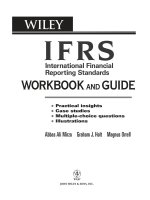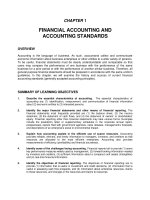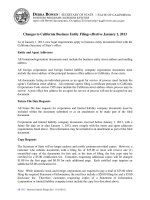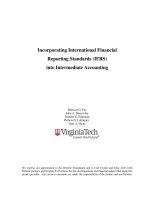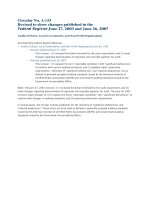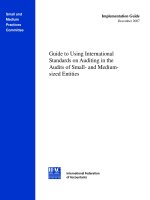IIA january summaryof standards changes
Bạn đang xem bản rút gọn của tài liệu. Xem và tải ngay bản đầy đủ của tài liệu tại đây (36.39 KB, 3 trang )
The
Institute
of
Internal
Auditors
(IIA)
issued
revisions
to
existing
standards
eligible
for
testing
on
the
IIA’s
Certified
Internal
Auditor
(CIA)
exam
on
and
after
January
1,
2017.
These
revisions
and
changes
primarily
focus
on
expanding
and
clarifying
the
interpretations
of
the
existing
standards.
This
document
will
provide
you
with
a
summary
of
the
substantive
changes
made
to
those
standards
which
could
impact
your
exam
experience.
1. Introduction:
a. The
first
purpose
of
the
Standards
listed
was
changed
from
“Delineate
basic
principles
that
represent
the
practice
of
internal
auditing”
to
“Guide
adherence
with
the
mandatory
elements
of
the
International
Professional
Practices
Framework”
(IPPF).
b. A
paragraph
was
added
that
states
that
the
Standards
and
the
Code
of
Ethics
are
considered
mandatory
elements
of
the
IPPF.
2. 1000
–
Purpose,
Authority,
and
Responsibility:
The
IPPF
full
mandatory
guidance
includes:
a. Mission
of
Internal
Audit
b. Core
Principles
for
the
Professional
Practice
of
Internal
Auditing,
c. Code
of
Ethics,
d. Standards,
and
e. Definition
of
Internal
Auditing
3. 1010
–Recognizing
Mandatory
Guidance
in
the
Internal
Audit
Charter:
clarification
of
standards
to
ensure
the
mandatory
guidance
listed
in
standard
1000
is
recognized
in
the
internal
audit
charter.
4. 1110
–
Organizational
Independence:
Disclosure
requirements
of
any
interference
have
been
added
to
1110.A1
5. 1112
–
Chief
Audit
Executive
Roles
Beyond
Internal
Auditing:
This
standard
is
new.
It
expresses
the
need
to
maintain
independence
and
objectivity
of
the
chief
audit
executive.
6. 1130
–
Impairment
to
Independence
or
Objectivity:
Paragraph
1130.A3
in
the
interpretations
is
new.
It
grants
permission
to
perform
assurance
services
for
a
former
consulting
client
provided
there
is
no
impairment
of
objectivity.
7. 1210
–
Proficiency:
Interpretation
expanded
to
include
“consideration
of
current
activities,
trends,
and
emerging
issues”.
8. 1300
–
Quality
Assurance
and
Improvement
Program:
Interpretation
expanded
to
encourage
board
oversight
of
quality
assurance
and
improvement
program.
9. 1312
–
External
Assessments:
Interpretation
expanded
to
state
that
the
external
assessor
may
comment
on
operations
or
strategy
and
the
assessor
must
comment
on
the
conformance
with
the
Standards
and
Code
of
Ethics.
The
interpretation
was
also
expanded
to
encourage
board
oversight
of
the
external
assessment.
10. 1320
–
Reporting
on
the
Quality
Assurance
and
Improvement
Program:
The
Standard
was
expanded
to
include
four
minimum
disclosure
requirements
such
as
the
scope
and
frequency
of
assessments,
the
qualifications
and
independence
of
assessors,
conclusions
of
assessors,
and
corrective
action
plans.
11.
2000
–
Managing
the
Internal
Audit
Activity:
The
interpretation
has
narrowed
the
term
“individuals”
to
“individual
members”.
The
interpretation
was
also
expanded
to
include
the
consideration
of
impactful
trends
and
emerging
issues
as
a
fourth
interpretation
of
an
effectively
managed
internal
audit
activity.
The
final
paragraph
of
the
interpretation
was
expanded
to
include
the
consideration
of
“strategies,
objectives,
and
risks”
in
a
value-‐adding
internal
audit
activity.
12. 2050
–
Coordination
and
Reliance:
“and
Reliance”
was
added
to
the
standard
title.
An
interpretation
was
added
to
help
better
understand
the
standard.
13. 2060
–
Reporting
to
Senior
Management
and
the
Board:
The
Standard
was
expanded
to
include
a
statement
on
the
conformance
with
the
Standards
and
the
Code
of
Ethics
in
the
report
to
senior
management
and
the
board.
The
interpretation
was
expanded
to
include
required
report
information.
14. 2100
–
Nature
of
Work:
The
interpretation
was
expanded
to
include
a
statement
that
the
credibility
and
value
of
the
work
is
enhanced
when
the
internal
auditor
is
proactive
and
consider
future
impact
in
their
evaluations.
15. 2110
–
Governance:
The
standard
was
expanded
to
include
two
additional
governance
tasks:
the
process
for
making
strategic
and
operational
decisions
as
well
as
the
process
for
risk
management
and
control
oversight.
16. 2200
–
Engagement
Planning:
The
standard
was
expanded
to
explicitly
state
that
the
engagement
plan
must
include
the
organization’s
strategies,
objectives,
and
risks.
17. 2210
–
Engagement
Objectives:
The
interpretation
of
this
standard
was
expanded
to
include
three
types
of
evaluation
criteria
such
as
internal,
external,
and
leading
practices.
18. 2230
–
Engagement
Resource
Allocation:
An
interpretation
was
added
to
this
standard.
19. 2330
–
Documenting
Information:
The
standard
was
expanded
to
include
sufficient,
reliable,
and
useful
to
the
description
of
“relevant
information”.
20. 2410
–
Criteria
for
Communicating:
Additions
were
made
to
2410.A1
to
be
more
specific
and
make
mandatory
about
the
inclusion
of
any
applicable
conclusions,
recommendations,
and/or
action
plans
in
the
final
engagement
communication.
21. 2450
–
Overall
Opinions:
The
standard
was
expanded
to
include
“strategies,
objectives,
and
risks”
in
the
overall
opinion.
The
interpretation
was
expanded
to
require
that
a
summary
of
the
information
that
supports
the
opinion
be
included.
22. Glossary
Changes:
the
following
glossary
terms
have
been
clarified
or
added
a. Board
b. Chief
Audit
Executive
c. Core
Principles
for
the
Professional
Practice
of
Internal
Auditing
(new)
d. International
Professional
Practices
Framework
Two
new
terms
“Mission”
and
“Core
Principles”
are
added
to
the
new
IPPF
of
2017,
as
follows:
The
Mission
of
Internal
Audit
articulates
what
internal
audit
aspires
to
accomplish
within
an
organization.
Its
place
in
the
new
IPPF
of
2017
is
deliberate,
demonstrating
how
practitioners
should
leverage
the
entire
framework
to
facilitate
their
ability
to
achieve
the
Mission.
“The
mission
of
internal
audit
is
to
enhance
and
protect
organizational
value
by
providing
risk-‐
based
and
objective
assurance,
advice,
and
insight.”
A
set
of
ten
Core
Principles
(CPs)
comprise
the
fundamentals
essential
to
the
effective
practice
of
internal
auditing.
They
are
the
foundational
underpinnings
of
the
Code
of
Ethics
and
the
Standards,
reflecting
the
primary
requirements
for
the
professional
practice
of
internal
auditing
now
and
in
the
future.
The
Core
Principles
can
be
used
as
a
benchmark
against
which
to
gauge
the
effectiveness
of
an
internal
audit
activity.
Thus,
the
Core
Principles
should
be
well
expressed
throughout
the
Code
of
Ethics
and
the
Standards.
CP1:
Demonstrates
integrity
CP2:
Demonstrates
competence
and
due
professional
care
CP3:
Is
objective
and
free
from
undue
influence
(independent)
CP4:
Aligns
with
the
strategies,
objectives,
and
risks
of
the
organization
CP5:
Is
appropriately
positioned
and
adequately
resourced
CP6:
Demonstrates
quality
and
continuous
improvement
CP7:
Communicates
effectively
CP8:
Provides
risk-‐based
assurance
CP9:
Is
insightful,
proactive,
and
future-‐focused
CP10:
Promotes
organizational
improvement
